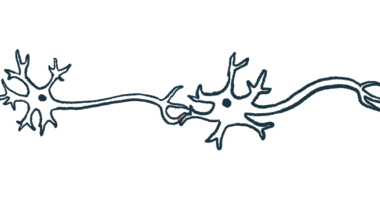#AANAM – Type 1 Infants Using Evrysdi for 2 Years Gaining in Skills

Evrysdi (risdiplam) continues to improve survival and to allow infants with spinal muscular atrophy (SMA) type 1 to achieve key motor milestones, according to two-year data from the second part of the FIREFISH trial.
“It is encouraging to see that infants continued to improve after 12 months of treatment, with twice as many of those who received Evrysdi for two years able to sit without support for at least five seconds,” Basil Darras, MD, a trial investigator and director of the Spinal Muscular Atrophy Program at Boston Children’s Hospital, said in a press release.
Treated infants “also experienced a range of improvements in motor function abilities, a reduction in serious events typically caused by disease progression, such as the need for permanent ventilation or hospitalization, and increased rate of survival,” added Darras, who is also a professor of neurology at Harvard Medical School.
These results were presented by Darras in the poster “FIREFISH Part 2: 24-month Efficacy and Safety of Risdiplam in Infants with Type 1 Spinal Muscular Atrophy (SMA),” at the 2021 virtual American Academy of Neurology Annual Meeting (AANAM), running through April 22.
Evrysdi works by increasing the levels of SMN, a key protein for motor neuron and muscle health and whose production is impaired in SMA patients. A flavored liquid, the therapy is administered daily at home by mouth or feeding tube.
It is approved in nearly 40 countries, such as the U.S., Canada, and those in Europe, as the first oral and at-home treatment for adults, children, and infants 2 months and older with all or nearly all SMA types. Identical approval requests are currently being reviewed by health authorities in more than 30 countries.
Levi Garraway, MD, PhD, the chief medical officer and head of global product development at Roche, one of Evrysdi’s developers, said “these data highlight the real-world impact of this transformative medicine in babies with the most severe form of SMA.”
Top-line results from the two-part, global Phase 2/3 FIREFISH study (NCT02913482) — which is testing Evrysdi in children enrolled at ages 1 to 7 months and with SMA type 1, a severe form — supported the therapy’s approvals and regulatory applications.
After determining Evrysdi’s optimal dose in 21 babies in part 1, the trial is evaluating the safety and effectiveness of the now-approved dose in another 41 type 1 infants, who began treatment at a median age of 5.3 months, in part 2.
Part 2’s main goal was to assess the percentage of these babies, now toddlers, who were able to sit without support for at least five seconds after one year of treatment.
Key secondary goals included changes in motor function and milestones — all assessed with validated measures — as well as in survival, and in their ability to breathe independently and to swallow.
One-year data from the second part of FIREFISH showed that the open-label trial met its main and most of its secondary goals, with Evrysdi treatment defying the natural progression of the disease and resulting in motor function gains and prolonged survival.
Newly presented findings concerned data from the second year of treatment during part 2, and showed continued survival and motor improvements.
After two years of treatment, “93% of infants were alive and 83% of infants were event-free [alive without permanent ventilation],” Darras said, adding that 95% of them were also able to swallow and 92% to be fed orally.
In a natural history study of SMA type 1, untreated babies required feeding support by 12 months old, and needed to be placed on permanent ventilation, or died, at a median age of 13.5 months.
Notably, there were no deaths between months 12 and 24, and the toddlers maintained their ability to swallow and to feed orally in the second year of treatment.
At year two, compared with the first year of treatment, twice as many patients were also able to sit without support for at least five seconds (61% vs. 29%) and at least 30 seconds (44% vs. 17%). All of those able to sit without support at one year maintained this ability at two years. Without treatment, type 1 children are never able to reach this milestone, Darras said.
A greater proportion of patients also achieved upright head control (63% vs. 44%), were able to roll to the side (44% vs. 10%), to stand with support (15% vs. 5%), and to walk (4% vs. 2%) in the second year of treatment.
Continued motor improvements were also seen in the CHOP-INTEND total score — whose scale ranges from 0 to 64 points, with higher scores indicating better motor skills — with a larger proportion of participants achieving a score of at least 40 at two years (76%) than at one year (56%) after treatment.
Without treatment, CHOP-INTEND scores for SMA type 1 babies drop over time, and a score of 40 or greater is rarely observed.
“We’re encouraged to see these patients reach key motor and mobility milestones, which would never have been realized in the natural course of the disease,” Stuart W. Peltz, PhD, co-founder and CEO of PTC Therapeutics, which was also involved in Evrysdi’s development, said in a separate press release.
Moreover, the number of hospitalizations were reduced by about 50% between the first and second year of treatment, and were fewer than those reported in natural history studies. Notably, one-third of these children did not require hospitalization during 24 months of treatment.
Evrysdi was generally safe, with a safety profile consistent with that reported in FIREFISH part 1 and in other studies. The most common adverse event was upper respiratory tract infection (54%), while pneumonia (39%) was the most frequent serious adverse event.
Rates of serious pneumonia were three times lower in the second year of treatment, compared with the first year. No treatment-related safety findings leading to withdrawal or treatment discontinuation were reported in part 2.
“The long-term data presented today build upon the robust pool of evidence supporting Evrysdi as a safe, effective and convenient at-home treatment option for SMA patients globally,” Peltz added.
After two years of treatment, children in FIREFISH are given the option of entering its open-label extension, in which they continue to receive Evrysdi for up to three years.







